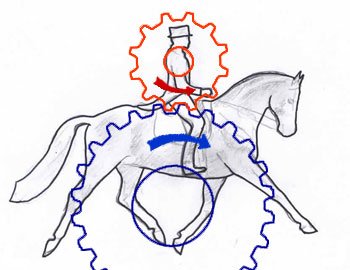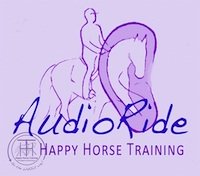|
Imperfect Horse Conformation
The question of how much horse conformation matters entirely depends on what matters to the individual rider. Horse riding is one of the few sports where humans can improve on their own performance considerably by finding a better partner. Or can they? In fact any improvement is rarely genuine, simply because it is a partnership. Not only this, the playing field is not level. Rider and horse perform different roles in this partnership, so it is unlikely that the horse can make up for the riders inefficiencies any more than the rider can make up for the horse. 
Both rider and horse are like cogs in one machine. The two cogs are different sizes and shapes, but they must both harmonize together to produce a true engagement. Engagement is the building block of dressage. This is why the rider's seat plays such a crucial role, it is the interface between rider and horse, the place where the two cogs meet. Imagine a bicycle chain in action, it must stretch and adhere to the structure beneath to transmit the movement. Otherwise the wheels will move without moving the bike! Unfortunately free-wheeling horses are a common site in the dressage arena. So the rider uses the connection with the horse's movement to channel that movement. This channeling involves straightening and balancing, which are two sides of the same coin. The rider's role, then, is principally postural control. For the Rider Going back to the original question, how does horse conformation influence our riding success? Like any question in life, there are always pro's and con's. If a rider seeks a horse with 'better' conformation they will indeed have less difficulty both straightening and balancing that horse. 
The counter balance to this, though, is that such a horse is likely to have more athletic, scopey paces, and a rider without enough postural strength and a sufficiently dynamic and flexible seat, will struggle to bring the best out in such a horse. This is the typical water-skiing-on-the-reins relationship we see in modern dressage (this photo, right, shows an extreme example of this). 
It is certainly not the fastest way to a red rosette, but the satisfaction and understanding gained outweighs the loss of an opportunity to show off! Horses are all born crooked to a greater or lesser extent. This is disguised to a greater or lesser extent by their conformational qualities. Finding and correcting this crookedness is the true role of the rider. This page introduce some of the horses we have worked with who have overcome severe horse conformation imperfections. Although their success in a dressage arena would be limited, especially now in the days of super-horses, they have won their own medals in terms of their accomplishments despite their physical limitations. 

Return from Imperfect Horse Conformation to Happy Horse Training home
|
New from HHT!
AudioRide is a series of exercises designed to listen to while you ride.
Audio descriptions guide you through each step of developing a balanced, dynamic connection with the horse through your position.
This truly innovative learning tool gives you a whole new way of being guided in your riding, in a calm, clear, step-by-step way.
Free Download! Introductory Exercise: Riding in the Now
Click here for full details
The Gymnastic Rider eBook
Now available exclusively from HHT! A unique, comprehensive guide to practical rider biomechanics. This professionally produced eBook takes the rider through the process of developing their body in the specific way that brings the horse's movement into harmony and balance - without force and constraint. Click here for full details, and to download the 15-page introduction for free.
Join the Happy Horse Training group on Facebook!
See and share topical info, news and photo's, and take part in lively discussions.
Click here to go to the HHT group and then click on the 'join group' button.
Join the Whole Horse Newsletter
HHT's free monthly newsletter giving you wide-ranging and intelligent insights into holistic horsemanship.
Just enter your details below to join.
Free bonus on the riding position with all new subscriptions: Ten Top Tips To Instantly Improve Your Connection With Your Horse.
Click here to see back issues of The Whole Horse newsletter
Train Your Horse
The Holistic Way
How To Train A Horse Without Force is a unique guide to training horses through energetic connection and gymnastic training. Part 1 covers everything on the ground, from handling to the lungeing technique that develops strength, straightness and engagement. Comes with a free eBook supplement on Horse Trauma.
Click here for more details.
What people say about the eBook:
"OMG! I'm BLOWN AWAY by this text [...] It's one of the best horse training texts I've ever read." - Wendy Kendall
"I realized that I haven't yet written you about the impact that your training e-book has had on me, and I want to let you know how inspiring and helpful I found it. As a student of Zen Buddhism for nearly three decades, I've often wondered when someone was going to write the book on Zen and the art of horsemanship, and I think that your emphasis on mindfulness and energy connection gets right at the heart of the matter. It has certainly deepened the way that I relate to and communicate with my horses. I am reasonably sensitive to horses' body language and mood, but new to me was the idea of feeling their energy in a more subtle way - including their connection with me even when I am not directly working with the them. I have made myself more aware of this communication, and it's pretty amazing. I have started grooming differently, too, treating a grooming session as a time to mindfully listen to my horse instead of a way to dust out an old rug (OK, I wasn't quite that bad, but you get the idea). Additionally, I have made myself more open to how I actually feel about the horses themselves - very enlightening. Overall, I think that you are saying something that no one else is saying but that everyone ought to hear." - Tess Lloyd
Do You Have
A Horse Story
To Share On HHT?
So many people have been through wonderful experiences with horses, whether in training or otherwise. If you've made a change in a horse's life - or one has made a change in yours - tell us about it here.
Learn How To Trim
Your Own Horse's Feet
The Simple Seven-Step Natural Trim is a comprehensive step-by-step guide to a cutting-edge barefoot trim. Click here to find out more.
What people say about HHT:
"The riding instruction is outstanding, if instructors in the UK taught this way there would be a lot of happy riders and horses."
"The riding tuition exceeded my hopes and expectations by a long way; giving me an exciting new facet to horsemanship which is lighter. more subtle, more elegant and more meaningful. It is as if a new door has opened bringing more sunlight and air."
"My goodness - what a change has taken place in my riding. I think that I'm starting to sit 'into' the horse rather than on top of him. I felt my horse's movements in a way that has almost never happened before"
Click on Testimonials for more





 The horse is the structural part of the bicycle, and the mechanism, the mover. His role is to move only. To willingly give up his body. This is where the line is often crossed, as riders often forget how important this willingness is in their relationship. A slave will never function in the same way as a partner, no matter how disguised that slavery may be.
The horse is the structural part of the bicycle, and the mechanism, the mover. His role is to move only. To willingly give up his body. This is where the line is often crossed, as riders often forget how important this willingness is in their relationship. A slave will never function in the same way as a partner, no matter how disguised that slavery may be.  We believe that the true art of dressage is to improve the natural paces of any horse, and this of course involves addressing any horse conformation issues or faults which influence the paces. Not only does this demand understanding of the horse but it demands also that the rider's own straightness and conformational aptitudes or faults to be recognized.
We believe that the true art of dressage is to improve the natural paces of any horse, and this of course involves addressing any horse conformation issues or faults which influence the paces. Not only does this demand understanding of the horse but it demands also that the rider's own straightness and conformational aptitudes or faults to be recognized.




